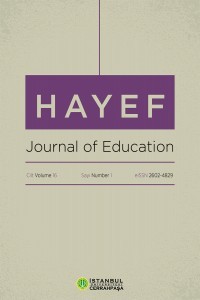MATEMATİK NEDEN BENİ KAYGILANDIRIR?
kaygı, matematik öğretimi, öğretmen
Why Does Mathematics Make Me Anxious?
anxiety, mathematics education, teacher,
___
- Alkan, V. (2010). Matematikten nefret ediyorum!. Pamukkale Üniversitesi Eğitim Fakültesi Dergisi, 28 (11), 189-199.
- Baloğlu, Mustafa. (2001). Matematik korkusunu yenmek, Kuram ve Uygulamada Eğitim Bilimleri Dergisi, 1 (1), 59-76.
- Bekdemir, M., A. Işık, Y. Çıkılı. (2004). Matematik kaygısını oluşturan ve artıran öğretmen davranışları ve çözüm yolları, Eğitim Araştırmaları Dergisi, 4 (16), 88-89.
- Biber, M. (2012). Duyuşsal Özelliklerin Probleme Dayalı Öğrenme Sürecinde Öğrencilerin Matematiksel Kazanımlarına Etkisi. (Yayımlanmamış Doktora Tezi). Dokuz Eylül Üniversitesi / Eğitim Bilimleri Enstitüsü. İzmir.
- Yenilmez, K. ve Özabacı, N. Ş. (2003). Yatılı öğretmen okulu öğrencilerinin matematik ile ilgili tutumları ve matematık kaygı düzeyleri arasındaki ilişki üzerine bir araştırma. Pamukkale Üniversitesi Eğitim Fakültesi Dergisi, 14 (2), 132-146.
- Butterworth, B. (1999). The Mathematical Brain. London: Macmillan.
- Cornell, C. (2000). Matematikten nefret ediyorum! (Çev.Nilüfer Eyüboğlu).Yaşadıkça Eğitim, 65, 15-22.
- Eldemir, H. H. (2006). Sınıf Öğretmeni Adaylarının Matematik Kaygısının Bazı Psiko-Sosyal Değişkenler Açısından İncelenmesi. (Yayımlanmamış yüksek lisans tezi), Cumhuriyet Üniversitesi,/Sosyal Bilimler Enstitüsü: Sivas.
- Fennema, E., & Sherman, J. A. (1976). Fennema-sherman mathematics attitudes scales: instruments designed to measure attitudes toward the learning of mathematics by females and males. Journal for Research in Mathematics Education, 7 (5), 324-326.
- Fiore, G. (1999). Math-abused students: are we prepared to teach them? The Mathematics Teacher, 90 (5), 403-406.
- Jackson, C.D., Leffingwell, R.J. (1999). The role of instructors in creating mathematics anxiety in students from kindergarten through. College. Mathematics Teacher, 92 (7), 583-586.
- Miles, M. B., & Huberman, A.M. (1994). Qualitative data analysis: a sourcebook of new methods ( 2nd ed.). Thousand Oaks, CA: Sage
- Üldaş, İ. (2005). Öğretmen ve Öğretmen Adaylarına Yönelik Matematik Kaygı Ölçeği (MKÖ-Ö)’nin Geliştirilmesi ve Matematik Kaygısına İlişkin Bir Değerlendirme. (Yayımlanmamış yüksek lisans tezi), Marmara Üniversitesi/Eğitim Bilimleri Enstitüsü: İstanbul
- Dey, I. (1993). Qualitative data analysis: a user-friendly guide for social scientists. London: Routledge.
- Greene, J. C., Krayder, H., & Mayer, E. (2005). Combining qualitative and quantitative methods in social inquiry. In B. Somekh & C. Lewin (Eds.). Research methods in the social sciences (pp. 275-282). London: Sage.
- Araujo, J., & Born, D. G. (1985). Calculating percentage agreement correctly but writing its formula incorrectly. The Behavior Analyst, 8 (2), 207-208.
- Yüksel-Şahin, F. (2004). Ortaöğretim öğrencilerinin ve üniversite öğrencilerinin matematik korku düzeyleri, Educatioal Sciences and Practice, 3 (5), 57-74.
- Gresham, G. (2010). A study exploring exceptional education pre-service teachers’ mathematics anxiety. IUMPST: The Journal 4 (2), 1-14.
- Clark, M. (2013). Teaching the Math Anxious Female Student: Teacher Beliefs about Math Anxiety and Strategies to Help Female Students in All-Girls Schools. (The degree of master of teaching), Department of Curriculum, Teaching and Learning Ontario Institute for Studies in Education of the University of Toronto: Canada
- Swanson, D. (2006). Math Anxiety What Can Teachers Do to Help Their Students over Come The Feeling?. In partial fulfillment of the requirements of the Math in the Middle Institute Partnership and the MAT degree.
- Tretter, Jacquelyn D., (2012). Mathematics Anxiety in Ninth-Grade Pre-Algebra. Masters Theses & Specialist Projects. Paper 1165. http://digitalcommons.wku.edu/theses/1165 Western Kentucky University, Bowling Green, Kentucky
- Plaisance, D. V. (2009). Mathematics anxiety of preservice elementary teachers after completing a problem solving. louisiana association of teachers (LATM) Journal, 5, (1), Nicholls State University Course http://www.lamath.org/journal/vol5no1/Math_Anxiety.pdf
- Başlangıç: 2004
- Yayıncı: İstanbul Üniversitesi-Cerrahpaşa
ÜSTÜN ZEKÂLI VE YETENEKLİ ÖĞRENCİLER İÇİN MATEMATİK MÜFREDATININ FARKLILAŞTIRILMASI
ÇOCUKLARIN ÇEVREYE İLİŞKİN GÖRÜŞLERİ: SALDA GÖLÜ ÖRNEĞİ
Osman YILMAZ, Selçuk BEDUR, Ruhi UYSAL
KAYNAŞTIRMA SINIF ÖĞRETMENLERİNİN KAYNAŞTIRMA KONUSUNDAKİ YETERLİLİKLERİNİN ARAŞTIRILMASI
ERGENLER İÇİN SOSYAL DIŞLANMA ÖLÇEĞİ: TÜRKÇE GEÇERLİK VE GÜVENİRLİĞİ
DEVELOPMENT OF A MATHEMATICAL ATTAINMENT SCALE AIMED AT UNIVERSITY STUDENTS
SINIFTAKİ FARKLILIKLAR İÇİN ÖĞRETMEN YETERLİKLERİ ÖLÇEĞİ’NİN TÜRKÇE UYARLAMASI
DİSİPLİNLERARASI ÖĞRETİM YAKLAŞIMI VE BİYOLOJİ ÖĞRETMENLİĞİ PROGRAMLARININ İNCELENMESİ
MATEMATİK DERSİNDE BİLGİSAYAR KULLANIMINA YÖNELİK ZİHİN ENGELLİLER ÖĞRETMENLERİNİN GÖRÜŞLERİ
Abdullah KAPLAN, Mesut ÖZTÜRK, Muhammet DORUK, Murat DURAN
ÖRNEK OLAY YÖNTEMİNİN HAYAT BİLGİSİ DERSLERİNDE KULLANIMINA YÖNELİK BİR EYLEM ARAŞTIRMASI
